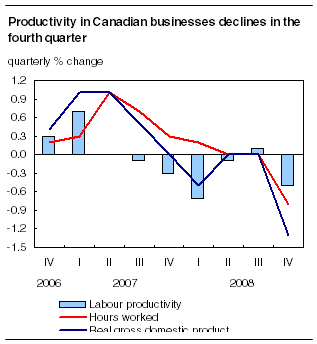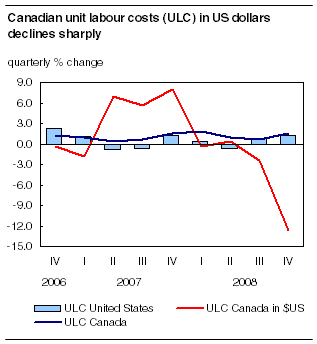Common menu bar links
Labour productivity, hourly compensation and unit labour cost
Archived Content
Information identified as archived is provided for reference, research or recordkeeping purposes. It is not subject to the Government of Canada Web Standards and has not been altered or updated since it was archived. Please "contact us" to request a format other than those available.
The labour productivity of Canadian businesses fell 0.5% in the fourth quarter, extending the period of weakness in the business sector that began in the second quarter of 2007.
In the fourth quarter, productivity declined as output dropped more rapidly than hours worked.
Chart 1

The real gross domestic product (GDP) of Canadian businesses shrank by 1.3% in the fourth quarter, reflecting weak domestic demand and the continuing slump in exports. This was the largest decline since the first quarter of 1991 when business sector GDP declined 2.2%.
At the same time, hours worked fell 0.8% in the fourth quarter of 2008 after remaining virtually unchanged in the previous two quarters.
The majority of industries experienced a drop in productivity in the fourth quarter. Wholesale trade, manufacturing and finance, insurance and real estate accounted for much of the decline.
In the United States, productivity in the business sector edged down 0.1% in the fourth quarter. It was the first quarterly decrease since the fourth quarter of 2007.
Labour costs per unit of production in Canadian dollars rose by 1.6% for Canadian businesses in the fourth quarter. This was just over twice the rate registered in the previous quarter (+0.7%).
Note to readers
This release contains a brief analysis of detailed data on labour productivity growth and other related variables. A more thorough analysis, including additional charts and tables, is available in the Canadian Economic Accounts Quarterly Review.
The term "productivity" in this release refers to labour productivity. For the purposes of this analysis, labour productivity, gross domestic product (GDP) and unit labour cost cover the business sector only.
Calculations of the productivity growth rate and its related variables in the text and tables of this release are based on index numbers rounded to three decimal places. On CANSIM, the calculations would be based on index numbers that are rounded to one decimal place.
Labour productivity is a measure of real GDP per hour worked. Productivity gains occur when the production of goods and services grows faster than the volume of work dedicated to their production.
Unit labour cost is defined as the cost of workers' wages and benefits per unit of real GDP, and is, therefore, a measure of upward or downward pressure on prices from wages.
Revisions
For this release, the Canadian estimates were revised retroactively to the first quarter of 2008.
Chart 2

The rise reflected the quarterly increase of 1.1% in hourly compensation, combined with the decline in productivity. In the first three quarters of 2008, the average quarterly growth rate of hourly compensation in Canada was 0.9%.
In the fourth quarter, the Canadian dollar depreciated by 14.1% relative to its American counterpart. Canadian unit labour costs measured in US dollars decreased substantially due to this depreciation.
American businesses saw their unit labour costs climb 1.3% in the fourth quarter, up from the growth rate of 0.8% for the previous quarter.
Annual 2008
For 2008 as a whole, labour productivity in the Canadian business sector fell 1.1%. It was the first annual decline since 1996.
In 2008, the production of goods and services by Canadian businesses fell by 0.3%. At the same time, hours worked continued to rise, albeit at only half the rate of the previous two years.
Despite a slight decrease in the fourth quarter, productivity in American businesses grew 2.7% for 2008 as a whole, appreciably higher than the annual rates for the previous three years.
This occurred in a context marked by a gradual slowdown in the annual growth rate of American GDP that began in 2005, and the first annual decrease in hours worked in five years.
Available on CANSIM: tables 383-0008 and 383-0012.
Definitions, data sources and methods: survey number 5042.
A more comprehensive analysis, including additional charts and tables, can be found in the fourth quarter 2008 issue of Canadian Economic Accounts Quarterly Review (13-010-XWE, free), which is now available from the Publications module of our website.
First quarter 2009 data for labour productivity, hourly compensation and unit labour cost will be released on June 16.
To order data, contact Client Services (productivity.measures@statcan.gc.ca). For more information, or to enquire about the concepts, methods or data quality of this release, contact Jean-Pierre Maynard (613-951-3654; fax: 613-951-3618; jean-pierre.maynard@statcan.gc.ca), Income and Expenditure Accounts Division.
Table 1
| Fourth quarter 2006 | First quarter 2007 | Second quarter 2007 | Third quarter 2007 | Fourth quarter 2007 | First quarter 2008 | Second quarter 2008 | Third quarter 2008 | Fourth quarter 2008 | |
|---|---|---|---|---|---|---|---|---|---|
| % change from previous quarter, seasonally adjusted | |||||||||
| Canada | |||||||||
| Labour productivity | 0.3 | 0.7 | 0.0 | -0.1 | -0.3 | -0.7 | -0.1 | 0.1 | -0.5 |
| Real gross domestic product | 0.4 | 1.0 | 1.0 | 0.5 | 0.0 | -0.5 | 0.0 | 0.0 | -1.3 |
| Hours worked | 0.2 | 0.3 | 1.0 | 0.7 | 0.3 | 0.2 | 0.0 | 0.0 | -0.8 |
| Hourly compensation | 1.5 | 1.6 | 0.2 | 0.4 | 1.3 | 1.2 | 0.8 | 0.8 | 1.1 |
| Unit labour cost | 1.2 | 0.9 | 0.3 | 0.6 | 1.5 | 1.9 | 0.9 | 0.7 | 1.6 |
| Exchange rate1 | -1.6 | -2.7 | 6.7 | 5.0 | 6.5 | -2.3 | -0.6 | -3.0 | -14.1 |
| Unit labour cost in US dollars | -0.4 | -1.9 | 7.0 | 5.7 | 8.0 | -0.3 | 0.3 | -2.4 | -12.7 |
| United States2 | |||||||||
| Labour productivity | -0.1 | -0.2 | 1.4 | 1.8 | -0.3 | 0.5 | 1.1 | 0.6 | -0.1 |
| Real gross domestic product | 0.4 | -0.2 | 1.4 | 1.3 | -0.2 | 0.2 | 0.7 | -0.4 | -2.2 |
| Hours worked | 0.5 | 0.0 | 0.0 | -0.4 | 0.1 | -0.4 | -0.5 | -1.0 | -2.1 |
| Hourly compensation | 2.1 | 1.0 | 0.6 | 1.1 | 0.9 | 0.9 | 0.5 | 1.4 | 1.2 |
| Unit labour cost | 2.2 | 1.1 | -0.8 | -0.6 | 1.2 | 0.3 | -0.7 | 0.8 | 1.3 |
| 2004 | 2005 | 2006 | 2007 | 2008 | First quarter 2008 | Second quarter 2008 | Third quarter 2008 | Fourth quarter 2008 | |
| % change from the previous year | % change from same quarter of previous year, seasonally adjusted | ||||||||
| Canada | |||||||||
| Labour productivity | 0.2 | 2.2 | 1.4 | 0.7 | -1.1 | -1.2 | -1.2 | -1.0 | -1.2 |
| Real gross domestic product | 3.2 | 2.9 | 3.1 | 2.6 | -0.3 | 1.0 | 0.0 | -0.5 | -1.8 |
| Hours worked | 3.0 | 0.8 | 1.6 | 1.9 | 0.8 | 2.2 | 1.2 | 0.5 | -0.6 |
| Hourly compensation | 3.3 | 4.8 | 5.0 | 4.3 | 3.8 | 3.1 | 3.8 | 4.1 | 4.0 |
| Unit labour cost | 3.1 | 2.5 | 3.6 | 3.6 | 4.9 | 4.4 | 5.0 | 5.2 | 5.3 |
| Exchange rate1 | 7.5 | 7.3 | 6.8 | 6.0 | 0.9 | 16.6 | 8.7 | 0.3 | -19.0 |
| Unit labour cost in US dollars | 10.9 | 10.0 | 10.6 | 9.9 | 5.7 | 21.8 | 14.2 | 5.4 | -14.8 |
| United States2 | |||||||||
| Labour productivity | 2.9 | 1.8 | 0.9 | 1.6 | 2.7 | 3.5 | 3.2 | 2.0 | 2.2 |
| Real gross domestic product | 4.2 | 3.5 | 3.0 | 2.0 | 0.8 | 2.8 | 2.0 | 0.2 | -1.8 |
| Hours worked | 1.2 | 1.7 | 2.1 | 0.5 | -1.9 | -0.7 | -1.2 | -1.7 | -3.9 |
| Hourly compensation | 3.8 | 3.9 | 3.8 | 4.2 | 3.7 | 3.5 | 3.4 | 3.7 | 4.0 |
| Unit labour cost | 0.8 | 2.1 | 2.9 | 2.6 | 0.9 | 0.0 | 0.2 | 1.6 | 1.8 |

